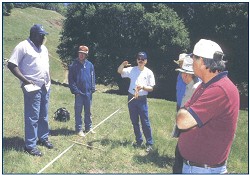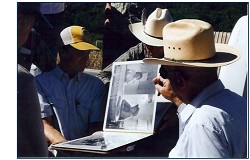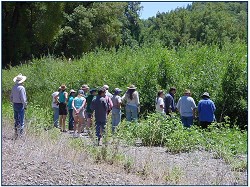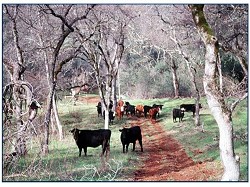Farm & Ranch Stewardship

Water Quality Management
There are several measures that agricultural producers can take to assess and improve water quality. The following UC Agriculture and Natural Resources (ANR) publications are helpful for understanding water quality and evaluating the impacts of individual agricultural operations:
- Nonpoint Sources of Pollution in Irrigated Agriculture
- Nonpoint Sources of Pollution on Rangeland
- Developing a Nonpoint Source Pollution Evaluation Program
- Evaluating Water Quality
- Groundwater Quality and Groundwater Pollution
The following ANR publications include useful information for agricultural producers looking to implement water quality protection practices:
- Practices for Reducing Nonpoint Source Pollution from Irrigated Agriculture
- Vegetative Filter Strips for Nonpoint Source Pollution Control in Agriculture
- Pesticide Choice: Best Management Practice (BMP) for Protecting Surface Water Quality in Agriculture
- Management Practices to Protect Water Quality: A Manual for Greenhouses and Nurseries
- Your Actions Can Help Preserve Drinking Water Quality
In addition, the USEPA's National Management Measures to Control Nonpoint Source Pollution from Agriculture outlines the best available, economically achievable means of reducing pollution of surface and groundwater from agriculture.
The following ANR publications discuss methods of monitoring water quality and documenting measures implemented to reduce nonpoint source pollution:
- Nonpoint Source Pollution Monitoring
- Sediment Delivery Inventory and Monitoring
- Groundwater Sampling and Monitoring
- Water Quality Record Keeping Guide
The following programs and organizations are available to assist landowners with water quality education, assessment and BMP implementation:

- The UC
Farm Water Quality Planning Program offers educational courses to producers of irrigated agricultural crops on the Central Coast of California. - The UC Ranch Water Quality Planning Program exists to improve water quality education to the rangeland industry in California.
- The California Rangeland Water Quality Management Program (CRWQMP) provides landowner nonpoint source self-assessments and landowner written water quality management plans.
- USDA's Natural Resource Conservation Service and local Resource Conservation Districts in Marin, Sonoma and Mendocino Counties are available to help agricultural producers identify water quality issues, develop goals and select management practices.
Conservation-Based Management
- UC's Sustainable Agriculture Research and Education Program (SAREP) provides leadership and support for scientific research and education in agricultural and food systems that are economically viable, conserve natural resources and biodiviersity, and enhance the quality of life in California's communities. Program areas include biologically integrated farming systems, community food systems, crop and livestock production, organic farming and methyl bromide alternatives.
- The USDA Water Quality Information Center's conservation-based management and nutrient management pages offer several online publications and manuals that outline best management practices (BMP's) for farmers and ranchers.
- The USDA Alternative Farming Systems Information Center (AFSIC) specializes in identifying resources about sustainable food systems and practices. The ASFIC website includes information on alternative crops, farm energy options, grazing systems, organic production, ecological pest management and more.
Riparian Corridor Management

- Forest Stewardship Series: Riparian Vegetation
- Visual Assessment of Riparian Health
- Maintaining Wood in Streams: A Vital Action for Fish Conservation
- Guidelines for Monitoring the Establishment of Riparian Grazing Systems
- Reducing Stream Impacts with Water Developments - An Example
See NRCS' information on vegetation buffers and our Stream & Upslope Restoration page for more information on maintaining and improving riparian areas.
Forest Stewardship
ANR's Forest Stewardship Series gives California forestland owners comprehensive information on the management and enjoyment of their lands. It is a good introduction to the lifelong study of forest stewardship that is part of owning forest property.
Road Construction & Maintenance

- ANR's Forest Stewardship Series: Forest Roads
- Pacific Watershed Associates Handbook for Forest and Ranch Roads
- Wildland Solutions Low Maintenance Roads for Ranch, Fire & Utilities Access
Pest Management
The following sources of information may be helpful to farmers weighing management decisions in regards to pesticide use and alternative pest management:
- UC's Statewide Integrated Pest Management Program (IPM) site contains valuable information on pesticides, including effects on water quality and pesticide safety and training. See our IPM page for information on pests specific to Marin, Sonoma and Mendocino Counties.
- UCCE Riverside's PesticideWise searches through a comprehensive EPA-USDA database and presents critical information on a specific pesticide's properties and water quality risks.
- AFSIC's Ecological Pest Management page contains information on complementary methods to control pests that minimize or eliminate the use of toxic pesticides.
- The USGS Pesticides in Groundwater page summarizes the problem of groundwater contamination by chemicals.
Residual Dry Matter Management for Ranchers
Residual dry matter (RDM), the amount of herbaceous plant material left standing or on the ground at the beginning of a new growing season, is a standard used for assessing the level of grazing use on annual grasslands and associated ecosystems. The following publications were developed to help land managers effectively manage RDM levels of California annual grassland range-types:
- ANR's Guidelines for Residual Dry Matter on Coastal and Foothill Rangelands in California
- Wildland Solutions' Residual Dry Matter (RDM) Photo-Guide
Horse Keeping & Manure Management
The Council of Bay Area Resource Conservation District Equine Facilities Assistance Program offers several useful publications that outline best management practices for clean water, manure management, invasive plant control and more for horse owners. Their horse keeping fact sheets are posted on this UC Davis' California Rangelands Program webpage.
Soil Survey Information
- The California Soil Resource Lab Online Soil Survey offers detailed soil data by street address.
- The NCSS Web Soil Survey offers printable soil maps by geographic area.
Environmental Regulations Pertaining to Agriculture
The USEPA has a new website that contains an easy and succinct look-up tool listing Federal Environmental Regulations with Potential Impacts on Agriculture. Knowing the regulations beforehand will allow farmers to address these issues before they become problems. This website aims to improve communication, collaboration and innovation between the agricultural community and federal regulators to build a more environmentally productive relationship.
Agricultural Funding Resources
- SAREP Funding Sources for Projects in Sustainable Agriculture, Food Systems and Organic Farming
- ASFIC Agricultural Funding Resources
- USDA Rural Information Center Small Farm Funding Resources

